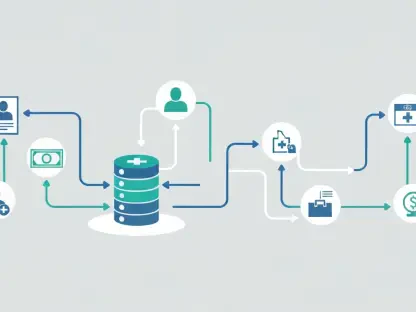In a landscape where technology evolves at breakneck speed, Google Cloud, a cornerstone of Alphabet Inc., has emerged as a formidable force with a staggering 32% revenue increase in the second quarter of this year, reaching an impressive $13.6 billion. This remarkable achievement signals not just financial growth but a profound shift in how cloud computing intertwines with artificial intelligence (AI) to redefine business capabilities. As companies across industries scramble to integrate advanced technologies, Google Cloud’s performance underscores a pivotal moment where AI isn’t merely an add-on but the very engine driving innovation and competitive advantage. With an annual revenue run-rate now surpassing $50 billion, the company is carving out a significant presence in the enterprise market, challenging long-standing norms of scalability and cost efficiency. This surge reflects a broader trend where access to cutting-edge tools becomes a critical determinant of success, positioning Google Cloud at the forefront of a transformative era in tech.
AI as the Growth Engine
Innovations Driving Success
The ascent of Google Cloud in the current market owes much to its relentless focus on AI, which has become the linchpin of its strategy. Central to this are the proprietary Tensor Processing Units (TPUs), hardware designed specifically for AI workloads, offering double the efficiency and a 50% performance boost over earlier versions. These advancements have attracted major players, including nine of the world’s largest AI research labs, to adopt the platform for their high-performance computing needs. Additionally, the Vertex AI platform, which facilitates the creation of custom AI models through a flexible consumption-based pricing model, has seen explosive growth, particularly in generative AI services. This surge, reported at a 140-180% increase in specific AI-driven cloud offerings, highlights how deeply integrated AI has become in enhancing both niche and mainstream services, setting a new standard for what cloud platforms must deliver.
Beyond hardware and platforms, Google Cloud’s ability to cater to complex, data-intensive workloads through AI innovations is reshaping customer expectations. Enterprises are no longer seeking mere storage or computing power; they demand tools that can accelerate machine learning, predictive analytics, and real-time decision-making. By embedding AI into its core offerings, Google Cloud has positioned itself as a preferred partner for businesses aiming to stay ahead in a digital-first world. This strategic alignment with market needs not only drives customer acquisition but also fosters loyalty among enterprises tackling intricate challenges. The emphasis on AI as a differentiator suggests that future growth will hinge on continuous innovation in this space, pushing the boundaries of what cloud services can achieve for diverse industries.
Transforming Industry Standards
Google Cloud’s AI-driven approach is not just boosting its own metrics but also redefining benchmarks across the cloud computing sector. The integration of generative AI solutions into everyday business operations is enabling companies to automate processes, personalize customer experiences, and unearth insights from vast datasets with unprecedented speed. This capability addresses a critical pain point for organizations that lack the resources to develop such technologies internally, making Google Cloud a vital ally in their digital transformation journeys. The ripple effect of this trend is evident as competitors scramble to match these offerings, signaling that AI proficiency is now a non-negotiable aspect of cloud service provision.
Moreover, the focus on AI is catalyzing a shift in how value is perceived in the cloud market. Traditional metrics like uptime and storage capacity are giving way to assessments of how well a provider can support AI-driven innovation. Google Cloud’s success in this arena, particularly with tools that simplify the deployment of custom models, sets a high bar for others to follow. This evolution suggests a future where cloud platforms are judged primarily on their ability to empower businesses with intelligent solutions, rather than just raw computational resources. As this paradigm takes hold, Google Cloud’s early and aggressive investment in AI positions it as a trailblazer, likely influencing strategic directions across the tech landscape for years to come.
Financial Milestones and Market Position
Revenue Growth and Profitability
The financial narrative of Google Cloud in the second quarter of this year paints a picture of robust growth and strategic maturity. With revenue soaring 32% to $13.6 billion, the company has demonstrated an exceptional capacity to scale its operations while catering to a growing enterprise base. Even more striking is the operating income, which more than doubled to $2.83 billion, achieving a healthy operating margin of 20.7%. This leap in profitability reflects a business model that has evolved beyond rapid expansion to focus on sustainable financial health, a critical factor for long-term success in a capital-intensive industry like cloud computing.
Complementing these figures is the annual revenue run-rate, which now exceeds $50 billion, underscoring Google Cloud’s entrenched position in the enterprise market. This financial strength is not merely a result of increased sales but also of strategic pricing and cost management that balance growth with efficiency. Such performance signals to investors and stakeholders alike that Google Cloud is not just riding a wave of industry trends but actively shaping its trajectory through disciplined execution. As the company continues to refine its operational framework, this balance of revenue growth and profitability will likely serve as a blueprint for sustaining momentum in a competitive field.
Competitive Edge and Market Share
In the fiercely contested arena of cloud computing, Google Cloud’s 32% revenue growth stands out against the backdrop of its rivals’ performances. Amazon Web Services (AWS) reported a respectable 17.5% increase to $30.9 billion, while Microsoft’s Intelligent Cloud group, including Azure, saw a 26% rise, with Azure itself growing by 39% in certain segments. Despite trailing in overall market share, Google Cloud’s higher growth rate indicates a potential shift in market dynamics, particularly in AI-driven sectors where it is gaining ground rapidly. This suggests that the company is not just competing but actively challenging the status quo with its specialized offerings.
Market share statistics further illuminate Google Cloud’s progress, with a record 13% of the global cloud market in the second quarter, up one percentage point from the prior year. Though it lags behind AWS at 30% and Microsoft at 20%, the committed deals backlog of $106 billion, a 38% year-over-year increase, points to strong future prospects. Notably, the doubling of high-value deals over $250 million and the volume of billion-dollar contracts signed in the first half of this year reflect deep enterprise trust in Google Cloud’s capabilities. This backlog ensures a robust revenue pipeline, positioning the company to potentially narrow the gap with competitors as these deals materialize into sustained income streams.
Infrastructure and Industry Impact
Capital Investment Strategy
Fueling Google Cloud’s ambitious growth is a substantial commitment to infrastructure, evidenced by Alphabet’s capital expenditure guidance of $85 billion for the current year. A significant portion of this investment, roughly two-thirds, is earmarked for servers and data center construction, highlighting the critical importance of physical assets in supporting the escalating demands of AI workloads. This strategic allocation ensures that Google Cloud can scale its global footprint to meet the computational needs of enterprises increasingly reliant on high-performance cloud services, maintaining its edge in a market where capacity often dictates capability.
This aggressive investment approach also reflects a long-term vision to stay ahead of demand curves, especially as AI applications require ever-greater processing power. By prioritizing infrastructure, Google Cloud is not only preparing for current needs but also anticipating future surges in usage as more industries adopt AI-driven solutions. Such foresight is essential in an environment where delays in capacity expansion can cede market share to faster-moving competitors. The scale of this expenditure underscores a belief that dominating the infrastructure race is as crucial as software innovation, setting the stage for Google Cloud to handle the next wave of technological advancements with confidence.
Supply Chain Ripple Effects
The impact of Google Cloud’s infrastructure investments extends far beyond its own operations, creating a cascade of opportunities across the technology supply chain. Companies involved in AI hardware, such as NVIDIA, Intel, and AMD, stand to benefit significantly from the heightened demand for GPUs and other specialized components essential for AI processing. Similarly, network equipment providers and data center construction firms are poised to see increased business as Google Cloud expands its global network of facilities to support its growing customer base, illustrating the interconnected nature of tech ecosystems.
Furthermore, this investment surge signals a broader industry trend where hyperscale cloud providers drive ancillary growth in adjacent sectors. As Google Cloud scales its data centers, it indirectly boosts innovation in energy-efficient technologies and sustainable building practices, areas critical to managing the environmental footprint of massive tech infrastructure. This ripple effect not only stimulates economic activity across multiple industries but also positions Google Cloud as a catalyst for technological and operational advancements. The broader implications suggest that such investments could redefine supply chain dynamics, encouraging partnerships and collaborations that further accelerate the pace of innovation in cloud and AI technologies.
Challenges and Future Outlook
Regulatory and Competitive Pressures
As Google Cloud cements its position through AI and market expansion, it faces the looming shadow of regulatory scrutiny that often accompanies rapid technological dominance. With AI becoming integral to critical infrastructure, concerns over data privacy, ethical implications of AI deployment, and market concentration are gaining traction among policymakers globally. Governments may push for greater transparency, interoperability standards, or even antitrust measures to ensure fair competition and protect consumer interests, echoing historical patterns where tech advancements outpace regulatory frameworks, necessitating subsequent intervention.
Simultaneously, the competitive pressure in the cloud computing space remains intense, with AWS and Microsoft Azure continuously enhancing their AI offerings to retain market leadership. Google Cloud’s impressive growth rate, while notable, must be sustained against rivals who are equally invested in capturing the AI-driven market. Smaller niche providers, unable to match the scale of hyperscalers, face existential challenges, potentially leading to market consolidation or a pivot to specialized segments. Navigating this dual challenge of regulatory oversight and fierce competition will require Google Cloud to balance innovation with compliance, ensuring it remains agile without overstepping boundaries that could invite restrictive policies.
Strategic Vision and Market Opportunities
Looking ahead, Google Cloud appears committed to deepening its AI focus, with plans to enhance TPU capabilities and expand the functionality of the Vertex AI platform. Short-term strategies include introducing more pre-trained generative AI models and tailoring specialized services for industries like healthcare, scientific research, and advanced manufacturing. With a $106 billion committed deals backlog, the company has a solid revenue pipeline ensuring sustained growth, while its long-term vision aims to establish it as the preferred partner for complex workloads, leveraging its infrastructure investments to meet escalating demands.
The broader market also presents a landscape ripe with opportunity and challenge as Google Cloud’s trajectory unfolds. Firms offering AI-specific tooling and consulting services may find fertile ground for collaboration, building solutions atop Google Cloud’s platforms. However, smaller cloud providers struggle to keep pace with hyperscalers, facing pricing pressures on basic services while premium AI offerings command higher margins. The potential for market consolidation through acquisitions of smaller players, combined with an accelerated pace of digital transformation across sectors, suggests that AI capabilities will remain the central battleground. Monitoring these evolving dynamics will be crucial for stakeholders aiming to capitalize on emerging trends in this rapidly shifting tech environment.









